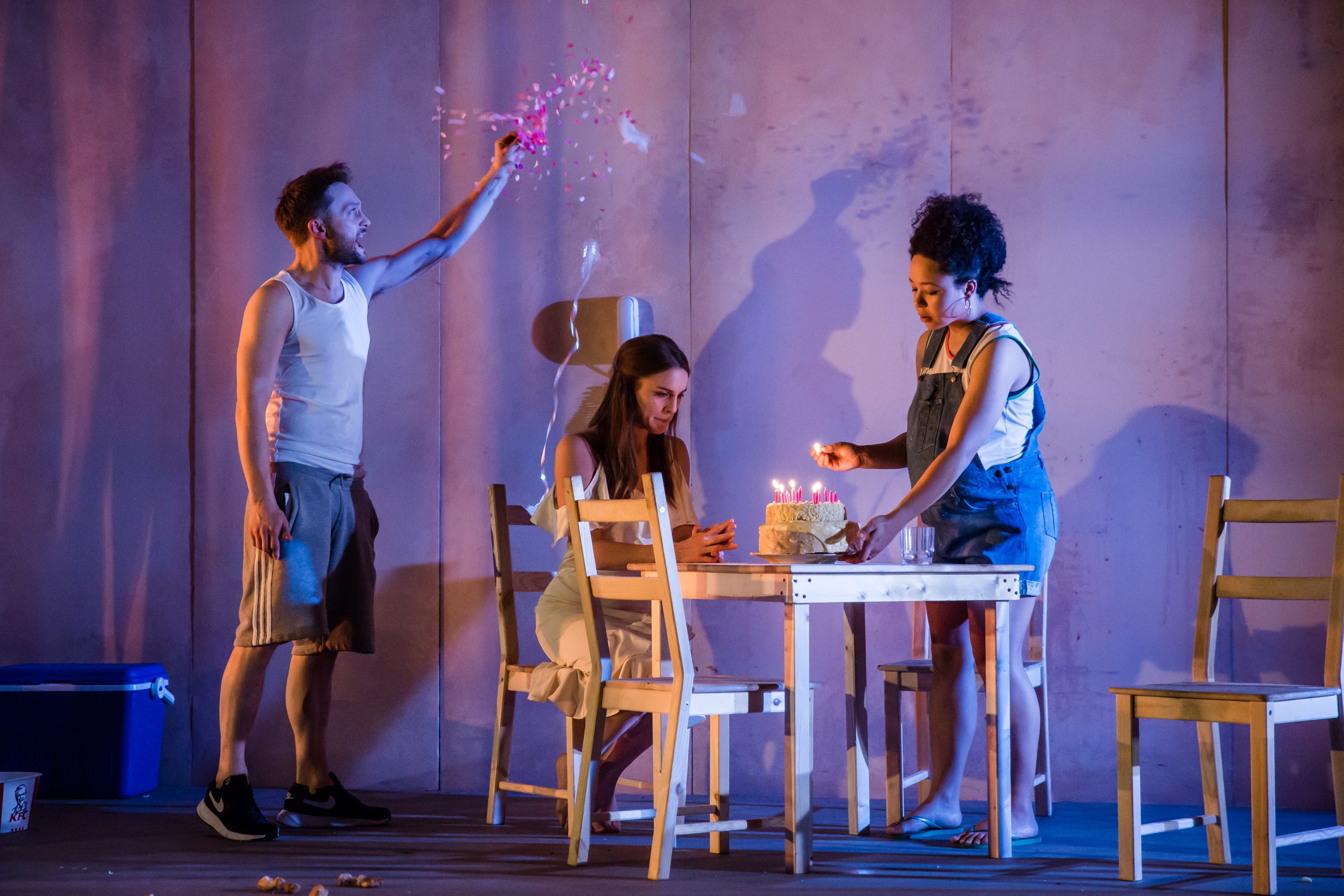Tennessee Williams’ A Streetcar Named Desire is a play so broad in its themes that the number of possible dramatic focus points seems infinite. The most obvious include the destructive, primitive, and inescapable nature of desire, and the decadence and decay of an entire social class as embodied by Blanche DuBois. This interpretation, produced by English Touring Theatre, Nuffield Southampton Theatres, and Theatr Clywd focuses on the first. Director Chelsea Walker takes the play from its 1940s context, placing it in 2018. A KFC bucket, Nike trainers, Bardot crop tops drag the script to the present day. The result, in the words of Walker, is a play that ‘unpicks toxic masculinity’, a thematic thread in that is certainly more obvious to an audience in 2018 than 1947.
The early scenes between Blanche (Kelly Gough) and Stella (Amber James) set up a sense of fragile sisterhood, the dynamic being one where Blanche does the talking. The actors conveyed the silent awareness between the sisters – that such an antiquated relationship, of an antiquated time, will not be sustained in Stella’s new life – in an understated and poignant manner. Stella’s life with Stanley was translated not only through her growing frustration with her sister’s airs, but through the lurid colours that, in this production, quite literally form the backdrop of her life, as Stanley, Mitch and Pablo burst onto the stage, wearing bold primary colours. It was an aesthetic reminiscent of Almodóvar, which is unsurprising, since Williams’ play formed a structuring device in the 1999 film Todo sobre mi madre. Walker’s production, like Almodóvar’s film, took specific interest in the theme of sisterhood and its doomed transition into a world ruled by the Stanley Kowalski types.
On a further aesthetic note, Georgia Lowe’s set design was crucial shedding light on the forces driving Stanley and Mitch’s behaviour. It was an aspect of the production which truly stood out. The set was sparse: two rooms, a bed, a table and chairs were all that was necessary to underline the two motivations, food and sex, that drive Williams’ characters. A mezzanine was suggestive of the claustrophobic atmosphere of Elysian Fields which exposed the visceral relationship between Eunice and Steve. In the final moments, it was an opportunity to recreate the iconic cover of the New Directions first edition of the text. Stanley was sitting atop the stage as the omnipotent force in the lives of the DuBois sisters, a shameless puppeteer.
It is understandable why the ‘modern’ set details were included – the audience was forced to contemplate how institutions may still conspire against the vulnerable, and still enable the dominance of Stanley (Patrick Knowles), and result in Stella’s to reject Blanche’s claims. However, this resulted in moments of discord between the 1940s script and creative choices. Impromptu discos to Madonna’s ‘Material Girl’, replacing the Varsouviana Polka motif with Blondie’s ‘Heart of Glass’ added little to the production. The latter inclusion spoilt the interaction between Blanche and the Evening Star delivery boy. The scene morphed into a sequence of contemporary dance. Rather than being a key moment where we audience witnesses the manipulative elements in Blanche’s character, the tone became too playful. ‘Heart of Glass’ played at a slow speed is not haunting, as the Polka would have been, but ghoulish. This may not have been an issue had the script been adapted to remove reference to the Polka, but this change had not been made. Changing the paper lantern, a prop of metaphorical significance, to a disco ball, may have been a nod to the updated sound design, but reduced the effectiveness of a central image.
Another moment that seemed slightly clumsy was the role of the flower seller, the ‘Mexican Woman’ of Williams’ text. Here, the character leapt into the Kowalski’s apartment, throwing flowers as confetti, wearing in Día de los Muertos make-up and shouted flores para los muertos [flowers for the dead]’. The cosmetics worked well, but the entrance into the apartment seemed to a too obvious symbol of Blanche’s upcoming breakdown.
These elements aside, centring upon what strikes us in 2018 as a damaging conception of masculinity offered a fresh way of interpreting Stanley and Mitch. When Mitch (a stand-out performance from Dexter Flanders) worries for his mother, and is embarrassed at the mess made by the poker party, he emerges with more integrity than the strutting peacock that is Kowalski. Again, the set design excels here. Mitch’s choice to sit with Blanche over Stanley, Steve and Pablo became a tableau depicting a character toying with a new conception of himself. He was rejecting his friends’ violence and demands for emotional distance.
The Stanley Kowalski of popular legend is a smouldering Marlon Brando. Knowles’ Kowalski was not smouldering. He was petty and spoilt. In fact, it seemed implausible that Stella would trust him over Blanche, which made the concluding scene difficult to accept. We consistently saw Blanche’s Stanley, rather than Stella’s. It may be questioned whether this was what a 1940s audience would have seen. However, these questions are irrelevant, since the work exists in 2018, and can be acted and interpreted accordingly, by individuals who more attuned to details in Williams’ script which critique of toxic codes of behaviour.
Ultimately, this production was daring. However, it needed to decide whether it was completely placing Williams’ characters in 2018. The props suggested this to be the case, yet elements in the script became anachronistic as a result. This should not however distract from the production’s success in presenting a Stanley Kowalski that challenged previous, romanticised portrayals.



